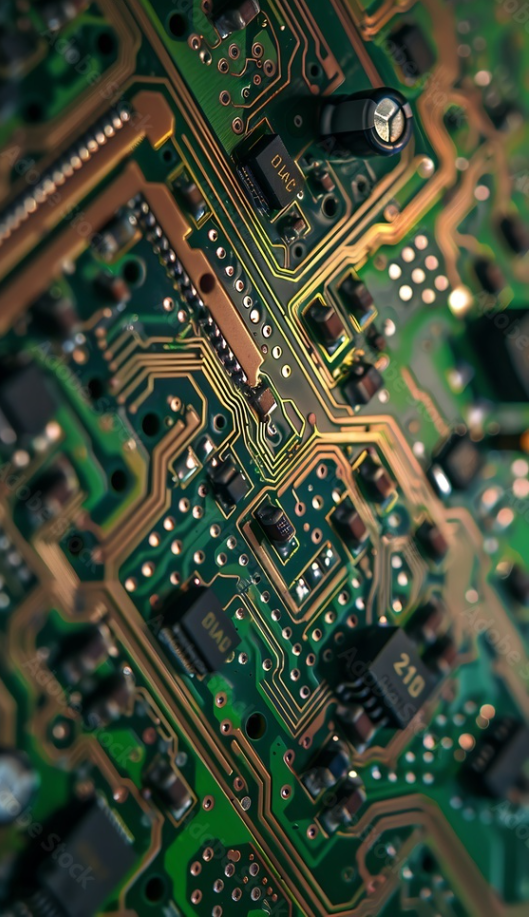
PCB Design
PCB design is considered the backbone of the electronics industry because it serves as the fundamental platform that enables the seamless integration of electronic components into functional circuits. It provides a structured and compact way to interconnect components using conductive pathways, ensuring reliable signal transmission and power distribution. A well-designed PCB enhances device performance by reducing electrical noise, managing heat dissipation, and ensuring mechanical stability. It enables the miniaturization of complex circuits, making electronic devices more efficient, lightweight, and cost-effective for mass production. From consumer electronics and medical devices to industrial automation and aerospace systems, PCB design plays a crucial role in nearly every modern technological advancement, making it an indispensable element of the electronics industry.
PCB design is crucial in modern electronics as it transforms circuit schematics into practical, manufacturable boards that drive various applications. It allows for precise component placement, efficient routing of electrical connections, and optimization of signal integrity, ensuring devices function reliably under different conditions. Advanced PCB technologies, such as multilayer boards, flexible PCBs, and high-speed designs, enable the development of compact, high-performance gadgets. Additionally, proper PCB design minimizes electromagnetic interference (EMI), enhances thermal management, and improves durability, making electronic products more robust. With rapid advancements in automation and IoT, PCB design continues to evolve, driving innovation in industries such as telecommunications, automotive, healthcare, and consumer electronics.
| Responsible | Enthu Technology |
|---|---|
| Last Update | 04/12/2025 |
| Completion Time | 21 hours 25 minutes |
| Members | 1336 |
Share This Course
-
-
PCB Design Fundamental
-
Electronics Components in PCB Design
-
PCB Design Rules and Components Arrangements
-
Polygon and Thermal Management
-
PCB Fabrication Process
-
PCB Design Syllabus
-
-
UNIT I: PCB Design Fundamentals
-
What is PCB and Application
-
Types of PCB & Substrate
-
PCB Terms
-
Types of Vias
-
IPC Standard
-
PCB Design Flow
-
-
UNIT II: Electronics Components in PCB Design
-
Active & Passive Components
-
Difference Between TH & SMD Components
-
SMD Components Package Types
-
SMD Components Value Identification
-
PCB Track Angle
-
0 Ohm Resister
-
-
UNIT III: PCB Design Rules & Components Arrangements
-
Components Arrangements in PCB Design
-
Track Width Calculation
-
Design Rule Parameters
-
-
UNIT IV: Polygon & Thermal Management
-
Polygon & Its Types
-
Thermal Management System
-
-
UNIT V: PCB Fabrication Process
-
PCB Fabrication Process
-
-
STUDY MATERIAL
-
UNIT I: PCB Design Fundamentals
-
Preview
-
Preview
-
Preview
-
Preview
-
-
Design Procedure in CAD Tool
-
Preview
-
Preview
-
Preview
-
Preview
-
Preview
-
-
PROJECT
-
1. Design a single-layer PCB for a circuit that blinks an LED at a controlled rate using a timer IC.
-
2. Design a PCB for a light-dependent resistor (LDR) based automatic light switch.
-
3. Design a PCB for a temperature sensor circuit that displays readings on an LCD screen.
-
4. Design a single-layer PCB for a small audio amplifier circuit using discrete components.
-
5. Design a PCB for a simple buzzer alarm circuit triggered by a pushbutton.
-
6. Design a single-layer PCB for a basic infrared remote control transmitter circuit.
-
7. Design a PCB for a circuit implementing basic logic gates (AND, OR, NOT) using discrete components.
-
8. Design a single-layer PCB for a simple metronome circuit with adjustable tempo control.
-
9. Design a PCB for a circuit that measures and displays battery voltage level.
-
10. Design a PCB for a circuit that encodes text messages into Morse code using LEDs or a buzzer.
-
11. Design a PCB for a basic FM radio receiver circuit with an antenna and audio output.
-
12. Design a double-layer PCB for a simple DC motor driver circuit with variable speed control.
-
13. Design a PCB for a weather station sensor that measures temperature, humidity, and pressure.
-
14. Design a double-layer PCB for a basic line follower robot using infrared sensors and motor control.
-
15. Design a PCB for a simple smart home device controller with functionalities like light control or temperature regulation.
-
-
ASSESSMENT
-
PCB Design Assessment
-
-
FEED BACK
-
Feedback Form
-